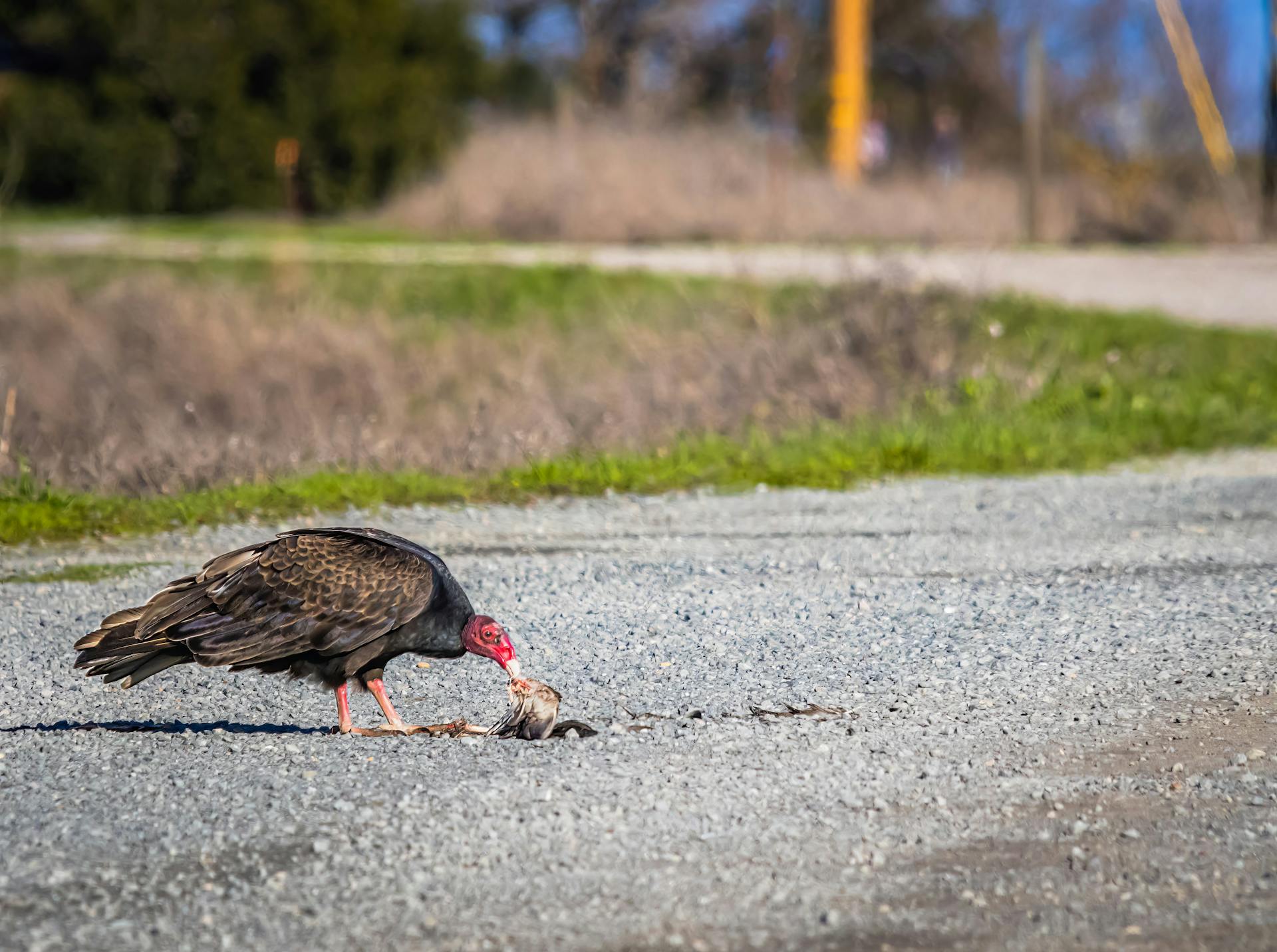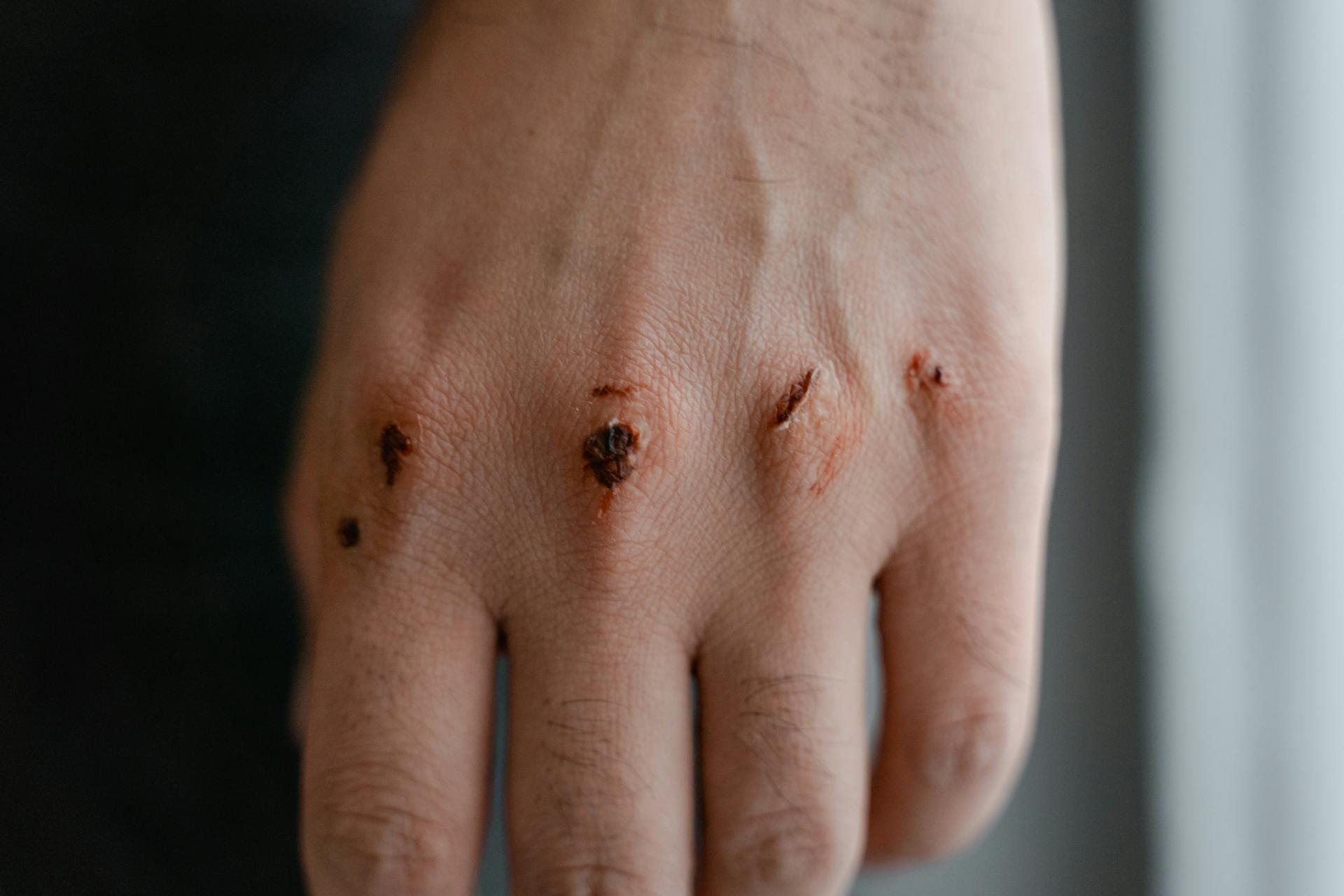
Flesh eating bacteria in dogs can be a serious and potentially life-threatening condition.
The bacteria that cause this condition, known as necrotizing fasciitis, typically enter the body through a cut or wound.
The most common bacteria responsible for necrotizing fasciitis in dogs are Streptococcus pyogenes and Clostridium perfringens.
These bacteria can quickly spread through the body and cause rapid tissue death, leading to severe pain and swelling.
Prompt veterinary attention is essential if you suspect your dog has contracted necrotizing fasciitis.
What is Fasciitis?
Fasciitis is a rare and grave disease that can result in systemic illness in dogs. It's often referred to as "flesh eating bacteria" due to its ability to destroy skin, fat, and muscles.
Necrotizing fasciitis is a bacterial soft tissue infection that appears suddenly. It's a serious condition that can lead to death in infected dogs.
This disease is difficult to diagnose as initial symptoms are similar to those of other less serious conditions.
Diagnosing and Treating Fasciitis
Diagnosing and treating necrotizing fasciitis in dogs requires prompt action. A veterinarian will confirm the diagnosis through bacterial culture and histopathological examination, but treatment must begin immediately to increase the chances of recovery.
The early signs of necrotizing fasciitis can be mistaken for other less serious problems, such as cellulitis. However, the severity of the pain experienced by the dog is often out of proportion to what can be seen on the skin.
The pain is caused by bacterial toxins and enzymes that damage tissue underneath the skin. This extensive tissue damage occurs before any noticeable changes appear on the surface.
A veterinarian will look for signs such as fever, localized swelling, and erythema to make a clinical diagnosis. If left untreated, the infection can progress rapidly, leading to serious systemic disease, including hypotension and sepsis.
Treatment involves administering intravenous antibiotics, such as clindamycin or amoxicillin-clavulanate, as soon as possible. The antibiotic may be changed once sensitivity testing results are available.
Other treatment options include intravascular fluid therapy, plasma transfusions, nutritional support, and surgically removing dead and infected tissue. In severe cases, amputation may be necessary.
It's essential to note that fluoroquinolone antibiotics should not be used, as they can increase the toxicity of the streptococcus strains.
Check this out: Treatment for Dogs Eating Rocks
Recovery and Prevention
Recovery from necrotizing fasciitis in dogs is a long and intense process.
You'll need to take your dog to multiple follow-up appointments for additional long-term treatment, which can be a significant commitment.
Cleaning your dog's wounds and frequently changing his bandages is crucial for preventing infection and promoting healing.
Antibiotics will need to be given for some time to help combat the bacterial infection.
Damaged areas will likely need to be repaired and reconstructed, which may require surgery and an anesthetic.
Skin grafts may be necessary to replace damaged skin and promote healing.
Following the instructions of your veterinarian is essential for helping your dog recover from necrotizing fasciitis.
Preventing necrotizing fasciitis in the first place is always the best option, and there are steps you can take to reduce the risk of infection.
Regular veterinary check-ups and keeping your dog's vaccinations up to date can help prevent the development of necrotizing fasciitis.
Understanding the Bacteria
The bacteria that cause flesh eating disease in dogs are quite specific. The most common culprits are Streptococcus canis, B-hemolytic streptococcus, Staphylococcus pseudintermedius, and E. Coli.
These bacteria can be found in various parts of the body, but the lungs and throat are the most likely places where your dog will contract the infection. Transmission can occur through sharing a water bowl, a run, or bedding with an infected dog.
Here are some of the bacteria that can cause necrotizing fasciitis in dogs:
- Streptococcus canis
- B-hemolytic streptococcus
- Staphylococcus pseudintermedius
- E. Coli
Causes of Fasciitis
Fasciitis can be caused by several types of bacteria, including Streptococcus canis, B-hemolytic streptococcus, Staphylococcus pseudintermedius, and E. Coli.
The lungs and throat are the most likely places where your dog will contract the bacteria.
Transmission of the bacteria can occur through sharing a water bowl, a run, or bedding with an infected dog.
Your dog could also acquire the bacteria by licking the face of a person who is carrying the bacteria or from being in crowded conditions with other dogs.
Stress, such as from traveling long distances, may also lead to a decreased resistance to the disease.
Here are some of the bacteria that can cause fasciitis in dogs:
- Streptococcus canis
- B-hemolytic streptococcus
- Staphylococcus pseudintermedius
- E. Coli
Symptoms of Fasciitis
Fasciitis, also known as necrotizing fasciitis, is a serious bacterial infection that can be life-threatening if not treated promptly. It's essential to recognize the symptoms early on to ensure your dog receives timely treatment.
The areas most likely to be affected by fasciitis are the hock joints, flanks, and skin on the abdomen. Your dog will likely be in a lot of pain, and the infection may start with a small skin lesion that quickly becomes a larger area of necrosis, often within just a few hours.
Other symptoms include fever, localized swelling, and erythema. The skin may shred and slough off within 24 to 48 hours, and your dog may exhibit signs of shock and disseminated intravascular coagulation.
Here are some common symptoms of fasciitis in dogs:
- Painful, deep lesions of the skin along your dog’s limbs or trunk
- Infection may start with a small skin lesion and progress to a large area of necrosis and ulceration within a few hours
- Pain initially seems out of proportion with what can be seen on the skin
- Fever
- Within 24-48 hours skin often sheds
- Localized swelling
- Erythema
- Signs of shock
- Disseminated intravascular coagulation
- Significant pain that seems out of proportion to what is seen upon physical examination
These symptoms can be similar to those of other conditions, making it challenging to diagnose fasciitis. However, if you suspect your dog has this disease, it's crucial to seek veterinary care immediately.
News and Alerts
A warning has been issued to dog owners across the UK about a flesh-eating disease that can be deadly to dogs.
Experts are asking dog owners to wash their pets' legs and paws after walking, in case they bring traces of the disease back with them.
The disease, also known as Cutaneous and Renal Glomerular Vasculopathy (CRGV), is especially prevalent in spring when the ground tends to dampen due to increased rainfall.
Key signs of the disease to look out for include sores which have not been caused by physical injury, appearing as lesions or red patches that can be swollen or ulcerous.
These sores can typically be spotted below the knee or elbow, but can sometimes show on the stomach or face.
One case of the disease has been reported near Poundbury, Dorset, a housing complex built under the guidance of King Charles III.
UK Health Warning Issued
A UK health warning has been issued over a flesh-eating dog disease spreading across the country.

Dog owners are being warned of a condition called Alabama Rot, also known as Cutaneous and Renal Glomerular Vasculopathy (CRGV).
This disease can be deadly to dogs and has been reported in Wales, Scotland, and parts of England this year.
One case was reported near Poundbury, Dorset, a housing complex built under the guidance of King Charles III.
Experts are now asking dog owners to wash their pets' legs and paws after walking, in case they bring traces of the disease back with them.
The disease damages a dog's blood vessels and kidneys, and can cause a dog's flesh to rot.
Key signs of the disease include sores that have not been caused by physical injury, which can appear as lesions or red patches and can be swollen or ulcerous.
These sores are typically spotted below the knee or elbow, but can sometimes show on the stomach or face.
Map Reveals Disease Hotspots
A map created by vet specialists Anderson Moores reveals where cases of Alabama Rot have been recorded in the UK, allowing worried owners to check if they may be near any previous instances.
Since 2012, 292 cases of Alabama Rot have been recorded, a condition that can be fatal as it blocks and damages the blood vessels in dogs' skin and kidneys.
The Kennel Club warns that cases "seem to be on the increase", although this could be a result of increased recognition of the condition.
Anderson Moores' map highlights areas where cases have been recorded, giving owners a better understanding of the disease's spread.
Experts recommend keeping your dog away from very muddy areas to potentially reduce the risk of Alabama Rot.
Checking over your dog's body regularly for any signs of ulcers or sores is also crucial, as is washing and drying your dog after a walk if they get wet or muddy.
Frequently Asked Questions
What is the survival rate for necrotizing fasciitis in dogs?
Unfortunately, the survival rate for necrotizing fasciitis in dogs is 0% without surgical intervention. Without prompt and aggressive treatment, including surgery, the outcome is typically fatal.
Is dog flesh eating bacteria contagious to humans?
No, dog flesh-eating bacteria (Necrotizing Fasciitis) is not typically contagious to humans, but good personal hygiene is still essential to prevent infection.
Sources
- https://www.today.com/health/man-who-lost-all-limbs-nose-dog-bacteria-capnocytophaga-i-t160075
- https://www.express.co.uk/news/uk/1873184/dogs-alabama-rot-map
- https://wagwalking.com/condition/necrotizing-fasciitis
- https://wagwalking.com/wellness/can-dogs-get-flesh-eating-bacteria
- https://www.chroniclelive.co.uk/news/uk-news/urgent-health-warning-issued-over-28939411
Featured Images: pexels.com


